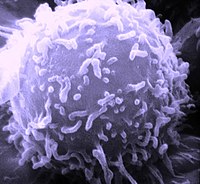
Photo from wikipedia
ABSTRACT The intestinal tract harbors a diverse community of microbes that have co‐evolved with the host immune system. Although many of these microbes execute functions that are critical for host… Click to show full abstract
ABSTRACT The intestinal tract harbors a diverse community of microbes that have co‐evolved with the host immune system. Although many of these microbes execute functions that are critical for host physiology, the host immune system must control the microbial community so that the dynamics of this interdependent relationship is maintained. To facilitate host homeostasis, the immune system ensures that the microbial load is tolerated, but anatomically contained, while remaining reactive to microbial invasion. Inflammation is the most prevalent manifestation of host defense in reaction to alterations in tissue homeostasis and is elicited by innate immune receptors that recognize and detect infection, host damage, and danger signaling molecules that activate a highly regulated network of immunological and physiological events for the purpose of maintaining homeostasis and restoring functionality. The efficacy, duration, and consequences of an inflammatory response is dependent upon the type of trigger that is recognized by the innate immune receptors. Further, because of different triggers, there are multiple phenotypes of inflammation. Physiological inflammation is the homeostatic balance between tolerance of the microbiota and the reactivity to pathogen invasion. Pathologic inflammation is usually an acute response that involves the host response to toxins and infection often resulting in collateral damage to surrounding tissue and increased metabolic energy use. Metabolic inflammation is a chronic low‐grade inflammation generated by excessive nutrient intake and the metabolic surplus fosters metabolic dysfunction by integrating signals from both the immune and metabolic systems. Sterile inflammation is a low‐grade chronic inflammation, in the absence of an infection, in response to chemical, physical, and metabolic stimuli. With a sterile inflammatory response, the stimulus persists without being eliminated suggesting that collateral damage is the cause of the disease. The common denominator with all intestinal inflammatory phenotypes is the central role of the gut microbiota whether it be microbial balance and diversity of microbial metabolic production or microbial turnover.
Journal Title: Poultry Science
Year Published: 2018
Link to full text (if available)
Share on Social Media: Sign Up to like & get
recommendations!